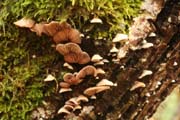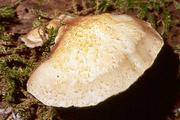Notes on CREPIDOTUS in the Pacific Northwest
Prepared for the Pacific Northwest Key Council
by Ian Gibson, South Vancouver Island Mycological Society
Copyright © 2007 Pacific Northwest Key Council
Photo copyright held by each photographer
Do not copy photos without permission
INTRODUCTION
Crepidotus fruitbodies are a familiar sight in the forests of the Pacific Northwest. They usually have whitish, pliable or delicate fruitbodies that attach laterally to wood, and the gills become brownish as spores mature. The standard reference in North America is the 1965 monograph by L. R. Hesler and A.H. Smith: North American Species of Crepidotus. They listed collections from the Pacific Northwest for 35 species, with about 125 taxa from North America.
Most non-specialists limit themselves to recognizing a few common species: Crepidotus applanatus, C. epibryus (= C. herbarum), and Crepidotus mollis. These species are described below. The others are usually designated as "Crepidotus sp." Determinations should be checked microscopically if accuracy is vital, and the monograph used to exclude other similar species. Identifications can also be listed as Crepidotus cf. applanatus etc.
Crepidotus is a member of Cortinariaceae in the 2001 edition of the Dictionary of the Fungi. There are more than 200 species worldwide. Aime et al.(2005) redescribe Crepidotaceae so that it includes Crepidotus and Simocybe.
The cap is generally from 1 to 5 cm across, colored whitish to yellowish brown. Shape may be roundish or it may be kidney-shaped with the attachment on the concave side. Flesh is thin and soft. No veil is apparent, and stem is short to absent. Fruitbodies grow laterally attached to wood. Spore deposit according to Arora is dull brown to yellow brown, cinnamon brown or pinkish brown. Under the microscope, spores are smooth to rough and do not have a germ pore.
The name "Crepidotus" may come from crepido = base or pedestal (Latin), ous, otos = ear (Greek). According to Schalkwijk-Barendsen it means "with a base like an ear".
There are a number of other common whitish fruitbodies growing laterally attached on wood. All of them have light-colored spores, but they may be easy to confuse with Crepidotus before its brown spores are evident on the gills. These may be explored in detail in the "Trial field key to the Pleurotoid Species in the Pacific Northwest" by Dorothy Brown. The most likely to be confused with the species listed here are Panellus species. Panellus longinquus (= Pleurotopsis longinquus) may be the most difficult. It grows mainly on red alder in coastal areas, or rarely on western hemlock. When it is gregarious none of the fruitbodies show the brown spore deposit of mature Crepidotus species. Panellus stipticus has an astringent peppery to bitter taste, unusual in Crepidotus, although Crepidotus mollis may occasionally be bitter. Panellus mitis has a fringed peelable cap margin, and separable gelatinous gill edges. Panellus serotinus and P. ringens are not whitish when mature.
SPECIES DESCRIPTIONS
Crepidotus applanatus var. applanatus (Pers.) P. Kumm. flat crep
CAP 1-4 cm, fan-shaped to petal-like, spathulate, kidney-shaped, or semicircular; hygrophanous, white, becoming brownish or somewhat vinaceous to buff or dull cinnamon; moist, bald or nearly so, may have hairs at the attachment, margin finely striate when wet; flesh thin, white. GILLS narrowly adnate-decurrent, radiating from point of attachment, close or crowded, narrow, subgills numerous; white, then brownish; edges fringed to even. STEM none. ODOR and TASTE mild. FRUITING in overlapping clusters on hardwood, more rarely on conifers. SPORE PRINT brown to cinnamon-brown. MICROSTRUCTURES spores 4-5(5.5) um in diameter, larger in var. globigera (5.5-7.5 um), round, punctate; basidia 4-spored; pleurocystidia none, cheilocystidia 20-40(50) x 5-10(12) um, clavate to ventricose, at times capitate; cap cuticle of repent hyphae, at times with scattered erect hyphae and cystidia, 25-65 x 5-10(12) um, clavate or ventricose; clamp connections present. REMARKS Distinguishing characteristics include white stemless cap; gills that are white at first, and close and narrow; small, round, minutely spiny spores (4-5.5 um); no pleurocystidia; and clavate to ventricose cheilocystidia, other varieties have different cheilocystidia or larger spores (5.5-7.5 um).
Crepidotus epibryus (Fr.: Fr.) Quél. sensu Senn-Irlet = Crepidotus herbarum (Peck) Sacc. little white crep
| CAP 0.8-2.2 cm, kidney-shaped or semi-circular to nearly round, margin incurved; white; dry, villose (with fine hairs) or tomentose (woolly-matted), becoming bald; flesh thin, white. GILLS radiating from a lateral or off-center point, subdistant, medium broad, white when young, finally pale ochraceous. STEM none, but cap strongly villose at point of attachment. FRUITING scattered or in groups on fallen hardwood logs, branches, and twigs, and on herbaceous stems. SPORE PRINT pale yellow-brown. MICROSTRUCTURES spores 6-10(11) x (2)2.5-3.5(4) um, cylindric to narrowly elliptic, often rather curved in side view, pale yellowish to yellowish; basidia 4-spored; cheilocystidia (14)25-80(87) x 2.5-6.5(7.5) um, narrowly lageniform to subcylindric-lageniform or somewhat fusoid, flexuous, contorted or coiled and then somewhat whip-shaped, with a neck more or less long, slender and at times forked, (1)1.5-3.5(4) um in diameter at apex, numerous, projected above spore-bearing surface, colorless, thin-walled; cap cuticle a trichoderm; clamp connections absent except at point of attachment of cap. REMARKS "The smooth, cylindric, pale basidiospores, the whip-like shape of the cheilocystidia, and the clampless hyphae are unique to C. epibryus." (Bandala et al. 1999). "The spores of C. herbarum are unique in the genus. They are pip-shaped to lanceolate, and pale brownish yellow in mass." (Hesler 1965). Because of the pale spores, Singer placed it in the genus Pleurotellus. | Crepidotus epibryus

A and O Ceska |
Crepidotus mollis (Fr.) Staude jelly crep, flabby Crepidotus
| CAP 1-5(8) cm, fan-shaped, kidney-shaped to somewhat rounded, soon flat, consistency flaccid; hygrophanous, olive brown when moist becoming shining and ochraceous-whitish when dry; gelatinous when wet, brownish fibrillose or scaly to apparently bald, margin with faint fine striations; flesh soft, thin, whitish. GILLS decurrent, radiating, crowded to close, broad to somewhat narrow, whitish, becoming cinnamon; the edges at times gelatinous and fringed. STEM absent or rudimentary. ODOR mild. TASTE mild or more rarely bitter. FRUITING usually in groups or overlapping rows on the bark of dead hardwoods or rarely conifers, spring, summer and fall. SPORE PRINT dull brown to yellowish-brown. MICROSTRUCTURES spores 7-8(10) x 4.5-5.5(6.5) um, elliptic, smooth; pleurocystidia none (except in var. cystidiosus found in Washington according to Hesler & Smith with pleurocystidia "at times found chiefly on the lower half of the gill", 47-52 x 5-6 um, "subcylindric or subfusoid, at times with a slight neck"), cheilocystidia of 2 types: 1) hymenial, 30-60 x 6-8 um, flask-shaped to irregularly cylindric, 2) tramal, 70-105 x 4-6 um, filamentous, the apices more or less enlarged, gelatinous; cap tissue interwoven with hyphae 5-12 um broad; cap cuticle a distinct gelatinous zone, 130-500 um thick, the hyphae interwoven and narrow (1.5-2 um), the surface bearing repent to erect tufts of fuscous or colorless hyphae, some of the former incrusted; clamp connections absent. REMARKS Features include relative large size (for a Crepidotus), fan-shaped or kidney-shaped to nearly round cap, gelatinous texture when wet, fibrillose scales on cap when young, absent or short stem, brown spore deposit, and microscopic characters. | Crepidotus mollis

Sharon Godkin |
REFERENCES
- Aime, M. Catherine, Rytas Vilgalys, and Orson K. Miller, Jr.. 2005. The Crepidotaceae (Basidiomycota, Agaricales): phylogeny and taxonomy of the genera and revision of the family based on molecular evidence.
- Arora, David. 1986 Mushrooms Demystified Second Edition. Ten Speed Press, Berkeley.
- Bandala, Victor M, Leticia Montoya, Gabriel Moreno. 1999. "Two Crepidotus from Mexico with notes on selected type collections." Mycotaxon 72: 403-416.
- Bandala, V.M, L. Montoya. 2000. "A taxonomic revision of some American Crepidotus." Mycologia 92(2): 341-353.
- Hesler, L.R., Smith, A.H. 1965. North American Species of Crepidotus. Hafner Publishing, New York.
- Schalkwijk-Barendsen, Helene M.E. 1991. Mushrooms of Western Canada. Lone Pine, Edmonton.
- END -

